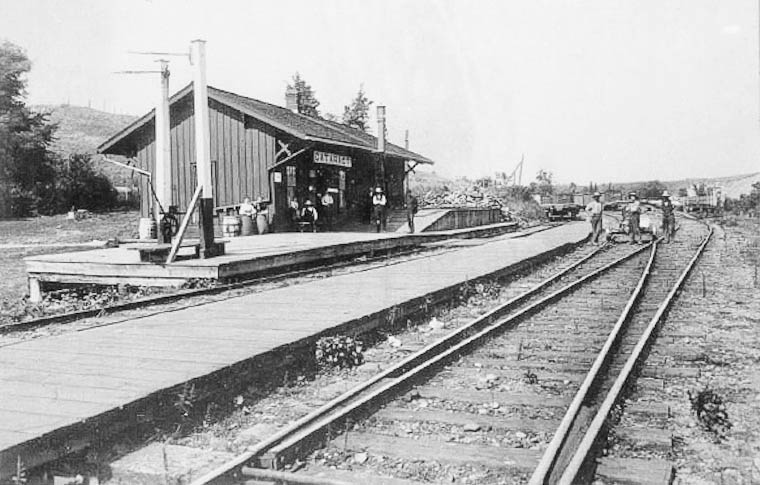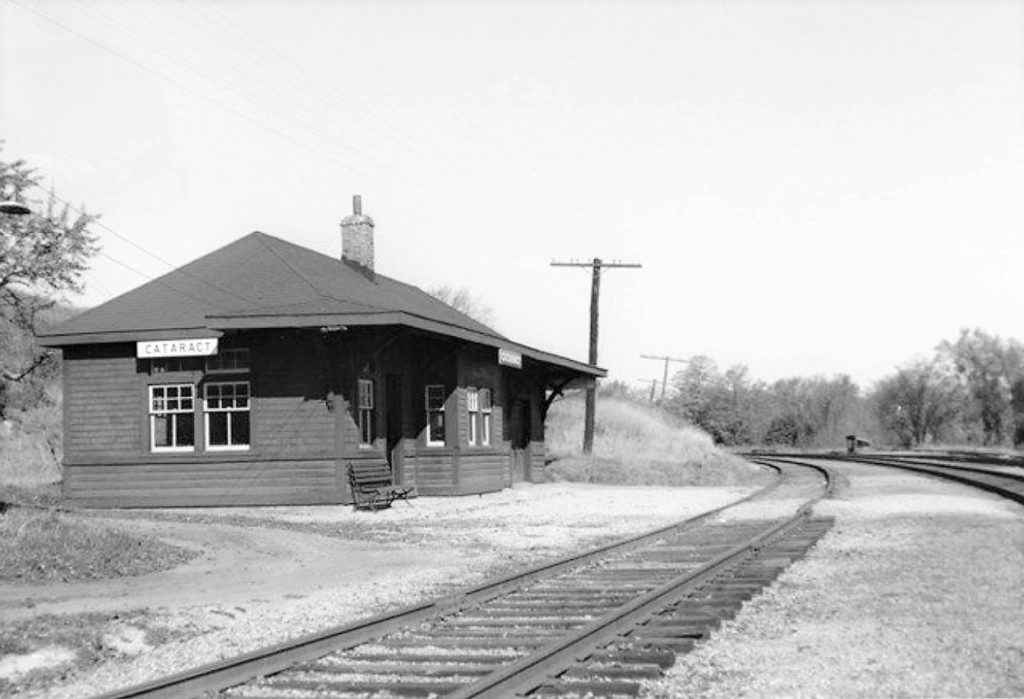Summary
The first train station in Cataract was built by the Credit Valley Railway in 1879 while construction on the line to Orangeville was simultaneously being conducted with construction on an additional branch line to Elora. Passenger service on both lines commenced by December of the same year. The station, originally called Church’s Falls, was a small board-and-batten structure identical to many other stations built by the Credit Valley Railway in other communities it served in its early years of construction. This one also featured a pair of wooden platforms, one attached to the station to serve trains to or from Elora and another for trains running on the Orangeville line. It was located at the end of a road which no longer exists, stretching approximately 400 metres north of a tight curve in nearby Cataract Road. A small turntable was also located due north of the station and across the tracks to turn around the equally small engines on the Elora run. The Canadian Pacific Railway gained control of the Credit Valley through one of its proxies, the Ontario & Quebec Railway, in 1883. Church’s Falls saw a total of eight passenger trains per day that year.
The station and the community that grew around it changed their names to Cataract by 1887. This term is used to describe a large waterfall, referring to the one nearby that was used to power a variety of industrial mills. The station’s name was specifically changed to Cataract Junction. Service would remain relatively consistent into the early 20th century, but for an unknown reason the station was replaced by a smaller and more contemporary structure in 1914. The new structure had a hipped roof with a canopy over the platform, as well as a square operator’s bay facing the tracks to provide visibility from the station agent’s office. The first major cutbacks to passenger service began as a result of the Great Depression, with service over the Elora branch reducing to just a single arrival and departure per day by 1931. The turntable was removed the following year, after which the remaining trains on the Elora branch would originate or terminate in Orangeville. Service on the Orangeville line had similarly been reduced to four departures per day, for a total of six trains stopping in Cataract altogether.
As automobiles started to appear during the early 20th century, branch line passenger ridership was one of the first things to feel the effects. Several old stagecoach routes in the area were turned into provincial highways in the 1920’s, allowing for a higher amount of car traffic at faster speeds than before. To help maintain passenger service, the conventional train consists on the Orangeville line started to be gradually replaced with economically efficient self-propelled Budd Rail Diesel Cars in 1956. The last train on the Elora branch would make its run on June 1st, 1957, after which the platform track for the Elora branch was removed. The entire wooden platform itself was removed at some point to save on maintenance costs, providing the dwindling passengers with a rather undignified experience. The success of Budd Rail Diesel Cars, which Canadian Pacific had dubbed “Dayliners”, resulted in a brief rebound in passenger service to seven trains per day by 1961. However, the station would be treated as a flag stop, meaning trains would need to be flagged down in the event a passenger was waiting. This was a common practice at the time meant to reduce unnecessary stops. The station windows were boarded up in spite of its active use by the early 1960’s, indicating that employees no longer worked there and the waiting room had become unavailable. The station was dismantled around the mid-1960’s and replaced with a tiny shelter in attempts to further reduce costs. Ridership continued to drop in spite of these efforts, and service to Cataract ended altogether in 1970 resulting in the removal of the shelter shortly thereafter.
Both lines remained in use by Canadian Pacific for local freight service. The line to Elora was torn up in 1987 after the remaining freight traffic ceased to operate. The right-of-way was then readapted as the Elora-Cataract Trailway. Canadian Pacific continued to use the Orangeville line for freight until 2000, when it was bought by the Town of Orangeville to ensure service would remain to the town’s industries. Operations were contracted out to Manitoba-based shortline operator Cando Rail. A tourist passenger excursion was established shortly after called the Credit Valley Explorer, bringing visitors from Orangeville to Snelgrove and back. Trillium Railway took over the contract in 2018, and the Credit Valley Explorer ceased to operate in February of that year. Freight service was terminated in December 2021 and the line was subsequently torn up with plans to turn it into another recreational trail.
Condensed Station Info:
| Location: | Served By: | Current State: | Date Built: | Date Demolished: |
| South of Cataract (No nearby roads) | Credit Valley (1879 – 1883) Canadian Pacific (1883 – 1970) | Demolished (All) | 1879 (First) 1914 (Second) 1960’s (Third) | 1914 (First) 1960’s (Second) 1970 (Third) |



